Color Profile[]
Color Profile is the term that we use to describe the color range of a bubble. Color profiles provide precise information about bubble film thickness and a great deal of useful information about the bubbles being made. The initial color profile tends to be quite consistent for a specific combination of juice, equipment and technique. The color profile is very helpful in tuning both juice, equipment, and technique.
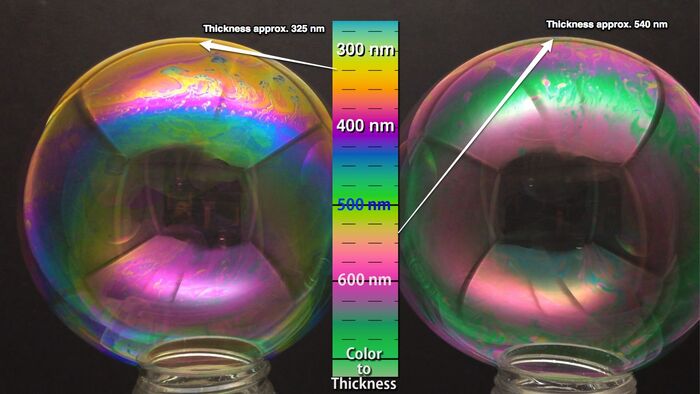
These bubbles made simultaneously with identical equipment display dramatically different color profiles. The profiles tell us that the bubble juice used for the lefthand bubble creates much thinner films than the solution used for the righthand bubble.
NOTE: See Color and Film Thickness for infomation about how bubble color and film thickness are related. It provides essential background for understanding this page.
A number of factors influence the color profile: bubble juice, lighting conditions, viewing angle, equipment, technique, and bubble expansion rate. For meaningful color profile comparison, it is essential to use fairly consistent lighting, viewing and environmental conditions. The color profile changes over time because bubbles thin due to the effects of gravity and evaporation. For comparisons to be meaningful, they must be made before the films colors start to shift. Of course, the rate at which they shift may provide valuable information about the bubble juice or environmental conditions. In low humidity, the bubble may thin significantly even as it is made. So, it is generally advisable to study profiles when there is enough humidity that the bubble film is not degrading rapidly.
Bubble juice dilution plays a critical role in the color profile and is a critical factor in tuning bubble film thickness. Solutions with a high surfactant concentration create thinner films than solutions with lower surfactant concentration. Some people find this counter-intuitive, but it is critical to understanding bubble juice. See the Dilution article for more information.
Equipment and method. Equipment and bubble-making techniques can influence the film thickness achieved with a particular juice. For example, you may find that the film thickness is different when using a tri-string bubble maker and when blowing bubbles with a small wand. When using a hoop, you may find that waving the hoop horizontally or blowing bubbles may result in a different color profile compared to sweeping the wand from low to high. SEPT 2017: Edward is finding that medium-sized tri-strings (such as 32" and 48" top-string wands) are more effective for observing differences in dilution than something like the longevity test setup.
As long as the bubble device has adequate capacity, the soap film will have what we call the default or typical profile (for that equipment) through a fair range of bubble growth.
Stretched Profiles. Under certain conditions a bubble film may be thinner than the default profile for that juice/equipment combination. For instance, if the bubble grows faster than the bubble device can supply juice, then the film may be thinner than usual. This thinning may also be seen as a bubble challenges the capacity of the bubble-making device. We call the range of colors that occurs in those conditions the stretched profile. When making bubbles, it is valuable to pay attention to this profile shift since it tells you that the film may be thinning to the point of breaking.
In the image below, you can see a tube at several stages as it grows. The bubble juice is a guar-based juice made with Dawn Pro and a dilution of 20:1. The first three stages have the default profile. In the latter stages of its growth, you can see a significant thinning of the film -- as the wick holds on to the bubble but is not able to supply enough juice (or enough juice fast enough) to allow the bubble to maintain its normal thickness. The stretched profile may appear for other reasons, too. (EDWARD: EXPAND THIS PARAGRAPH WITH MORE ABOUT WHEN THIS CAN HAPPEN)
See also: Dawn Pro Dilution Evaluation
Dawn Pro at 20:1[]
Detergent: 2014 Dawn Pro Manual Pot and Pan detergent. Session: 2014.
The photo sequence below was taken on a very overcast morning with 80% humidity as a bubble tube grows. This was a guar-based bubble juice. The first three images show the normal color profile for this dilution. The fourth and fifth images show a stretched profile near the loop. These are colors associated with a thinner film. See the scale in the article Color and Film Thickness to see how color maps to thickness.
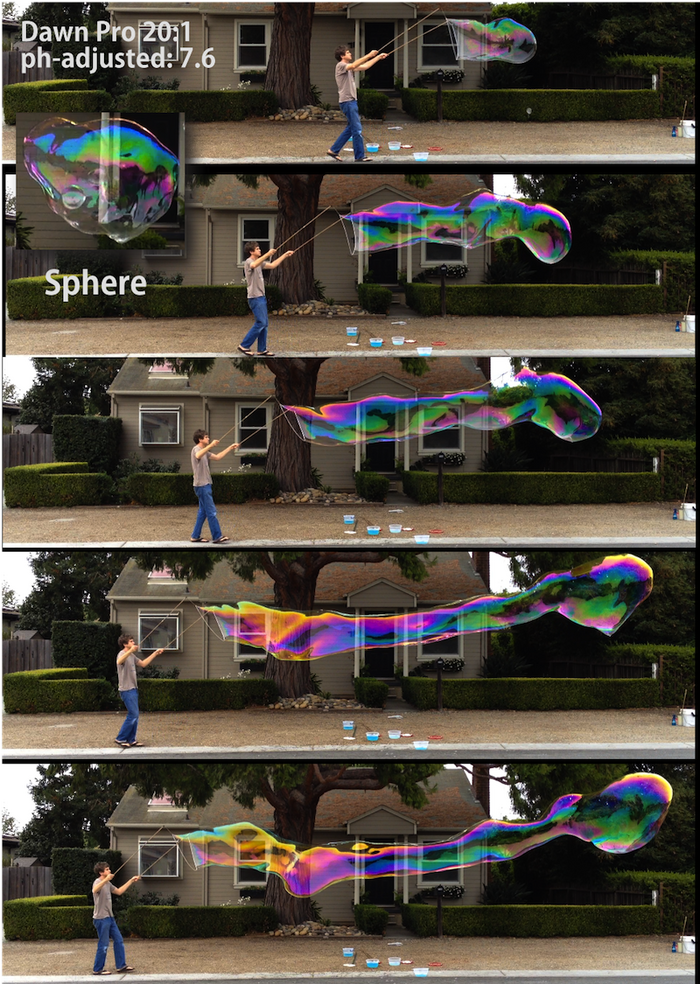
The picture below shows the influence that pH adjustment can have on 20:1 Dawn Pro dilutions.
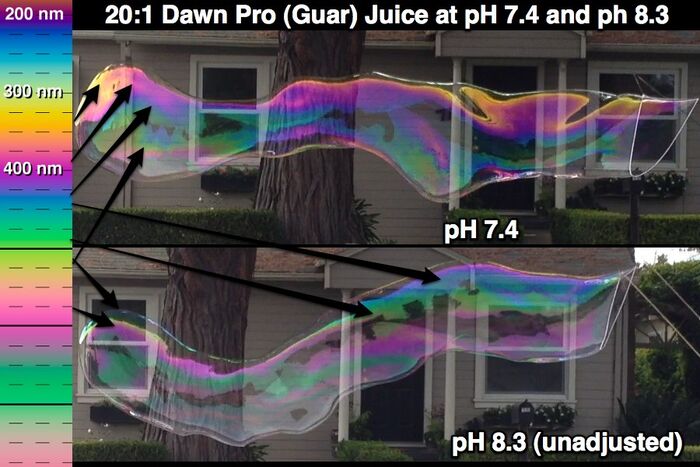
Preliminary color study showing Dawn Pro solutions at 20:1 with different pH
Dawn Pro at 16:1[]
Detergent: 2014 Dawn Pro Manual Pot and Pan detergent. Session: 2014. Wand: 30" top-string. SecureLine diamond braid cord.
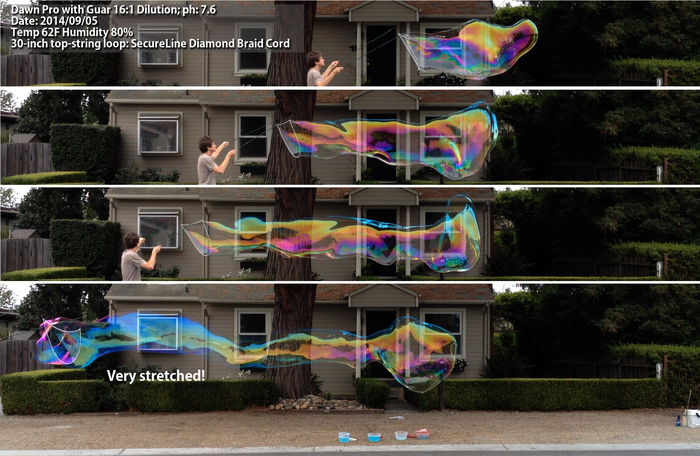
More Examples[]
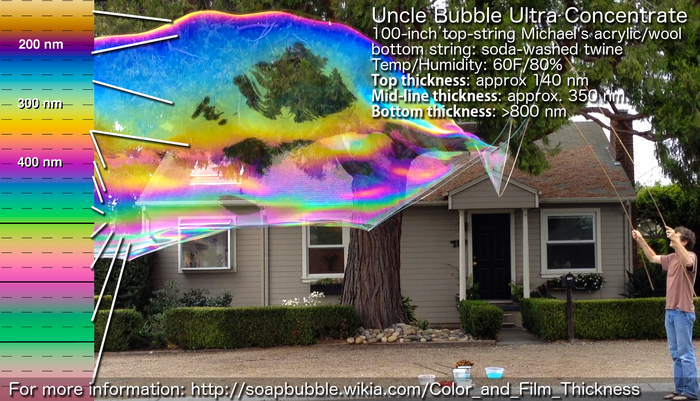
Color profile of Uncle Bubble on a cloudy humid morning
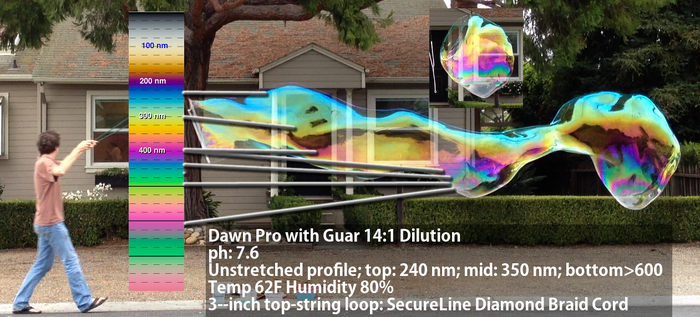
Color Profile of Dawn Pro at 14:1 (water:Dawn Pro) on a very cloudy humid morning.
Stretched Profile Notes[]

Observe how much thinner the film is in the region near the loop than at the leading edge which has the "normal" color profile. Notice how the green color is not present near the loop. This bubble made with a 20:1 Dawn Pro solution pH-adjusted to 7.6
One can see a shift from the normal to the "stretched" profile for a number of reasons:
- Thinning as loop becomes exhausted or can no longer satisfy rate of expansion. As the wick becomes exhausted of juice, it may not be able to provide as much juice as the bubble demands. So, the film stretches similarly to the way that a length of saran wrap or plastic cling film would if you held one end and pulled at the other. The bubble's film stretches as it is pulled from the loop.
- Thinning of the film due to evaporation. This is common when it is warm or the humidity is less than ideal. It also happens if making bubbles in direct sun even if the air temperature is cool. There is a lot of energy in sunlight which is why it can be quite warm inside a car that is left in the sun even on a cool day.
- Thinning due to rapid expansion. If the air is moving fast, it may cause the bubble to grow faster than the wick can feed the bubble. After a bubble is closed, when there are swirling winds, there can be low and high pressure pockets that cause closed bubbles to rapidly expand which will cause the bubble to grow and the film to stretch.
- Thinning due to uneven release of water and detergent. Some (perhaps all?) wicks seem to release the water and detergent at slightly different rates. This seems to result in an increasing soap concentration in some cases.